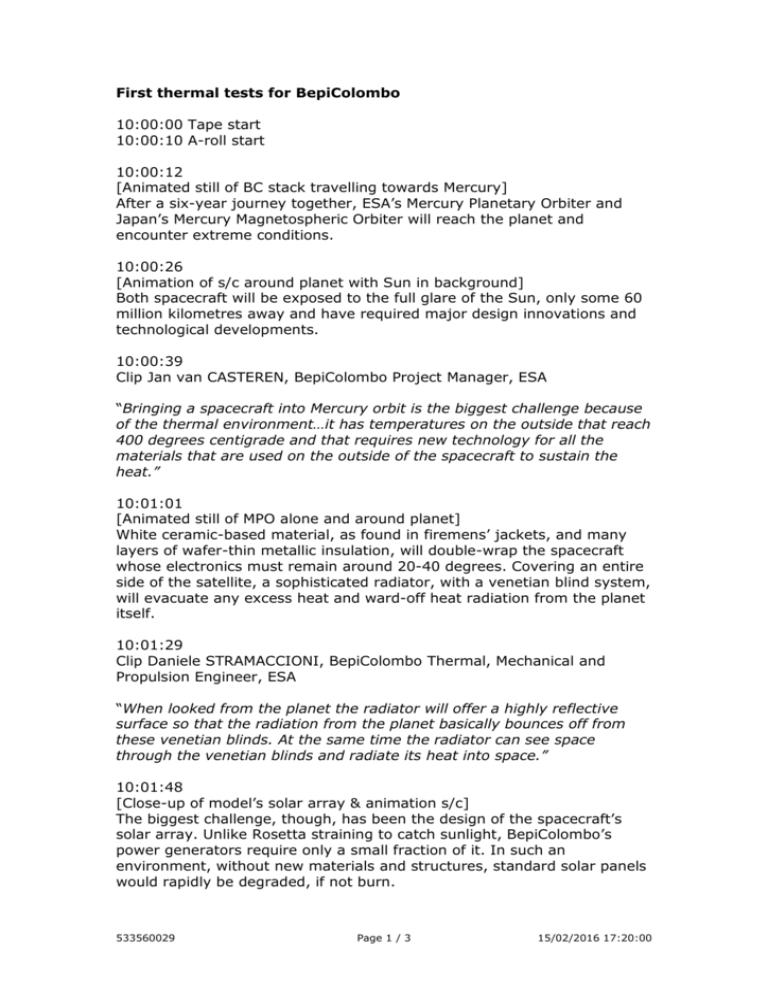extreme around
advertisement

First thermal tests for BepiColombo 10:00:00 Tape start 10:00:10 A-roll start 10:00:12 [Animated still of BC stack travelling towards Mercury] After a six-year journey together, ESA’s Mercury Planetary Orbiter and Japan’s Mercury Magnetospheric Orbiter will reach the planet and encounter extreme conditions. 10:00:26 [Animation of s/c around planet with Sun in background] Both spacecraft will be exposed to the full glare of the Sun, only some 60 million kilometres away and have required major design innovations and technological developments. 10:00:39 Clip Jan van CASTEREN, BepiColombo Project Manager, ESA “Bringing a spacecraft into Mercury orbit is the biggest challenge because of the thermal environment…it has temperatures on the outside that reach 400 degrees centigrade and that requires new technology for all the materials that are used on the outside of the spacecraft to sustain the heat.” 10:01:01 [Animated still of MPO alone and around planet] White ceramic-based material, as found in firemens’ jackets, and many layers of wafer-thin metallic insulation, will double-wrap the spacecraft whose electronics must remain around 20-40 degrees. Covering an entire side of the satellite, a sophisticated radiator, with a venetian blind system, will evacuate any excess heat and ward-off heat radiation from the planet itself. 10:01:29 Clip Daniele STRAMACCIONI, BepiColombo Thermal, Mechanical and Propulsion Engineer, ESA “When looked from the planet the radiator will offer a highly reflective surface so that the radiation from the planet basically bounces off from these venetian blinds. At the same time the radiator can see space through the venetian blinds and radiate its heat into space.” 10:01:48 [Close-up of model’s solar array & animation s/c] The biggest challenge, though, has been the design of the spacecraft’s solar array. Unlike Rosetta straining to catch sunlight, BepiColombo’s power generators require only a small fraction of it. In such an environment, without new materials and structures, standard solar panels would rapidly be degraded, if not burn. 533560029 Page 1 / 3 15/02/2016 17:20:00 10:02:11 Clip Antonio CAON, BepiColombo, Solar Array Engineer, ESA “We have also to use not only solar cells in the panel but also mirrors to get rid of most of the light that enters into the panel. Even if I put edgeon the solar array, so the solar cells are more or less not exposed to the sunlight, but due to the infrared from the planet the temperature could reach 140-150 degrees centigrade.” 10:02:37 [Large Solar Simulator with MMO and sunshield] The tests just completed saw the Japanese orbiter and its European-made protective sunshield placed in ESA’s Large Solar Simulator in Noordwijk. This unique European test facility had to be upgraded with even more powerful lamps and specially focused mirrors to recreate the intense thermal conditions around Mercury. 10:03:01 Clip Jan van CASTEREN, BepiColombo Project Manager, ESA “It is the very first time that we see on a spacecraft scale what is the behaviour of the thermal system and in particular the behaviour of the high temperature thermal blankets, how much heat do we get through the blankets into the spacecraft.” 10:03:19 [More shots of MMO and sun-shield in LSS, animations of both s/c around planet] These tests constitute a major step for ESA engineers and prime contractor EADS Astrium, also closely followed by the mission scientists. Upon the spacecrafts’ survival, of course, depend the science data from the dozen instruments on the European probe and those of its Japanese partner - to understand, for instance, the planet’s magnetic fields. 10:03:43 Clip Johannes BENKHOFF, BepiColombo Project Scientist, ESA “We can have gradient measurements from one spacecraft to the other, or two spacecraft in an orbit around the planet where we have two points in order to better characterise the magnetic field.” 10:03:59 [Still animations of NASA MESSENGER images of Mercury] The scientist have many other questions about Mercury: the nature of its core (is it liquid or solid), the origin of the many long scarps across its surface, and - paradox of this intensely hot planet - the eventual presence… of water and ice at its poles. 10:04:20 Credits 10:04:24 End of A-Roll B-Roll 533560029 Page 2 / 3 15/02/2016 17:20:00 Interviews Jan van CASTEREN, BepiColombo Project Manager, ESA 10:04:29 Heat, the biggest challenge (English) 10:04:57 The completion of the first thermal tests (English) 10:05:20 Heat, the biggest challenge (Dutch) 10:05:41 The upgrading of the test facilities (Dutch) Daniele STRAMACCIONE, BepiColombo Thermal, Mechanical & Propulsion Engineer, ESA 10:06:22 The Planetary Orbiter’s radiator (English) 10:06:48 The extreme conditions around Mercury (Italian) Antonio CAON, BepiColombo Solar Array Engineer, ESA 10:07:40 The use of mirrors on the solar array (English) 10:08:00 The radiation from the planet itself (English) 10:08:19 My most challenging mission (Italian) Johannes BENKHOFF, BepiColombo Project Scientist, ESA 10:08:51 A 3D view of the planet’s magnetic fields (English) 10:09:13 ditto (German) ESTEC Large Solar Simulator BepiColombo first tests - GV 10:09:42 10 shots showing chamber, MMO and its sunshield Animations 10:10:35 Orbits of the two spacecraft 10:11:04 Orbits of two spacecraft and magnetic fields 10:11:47 End of B-Roll 533560029 Page 3 / 3 15/02/2016 17:20:00







